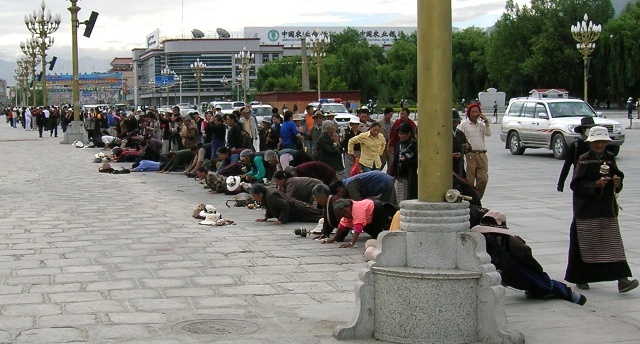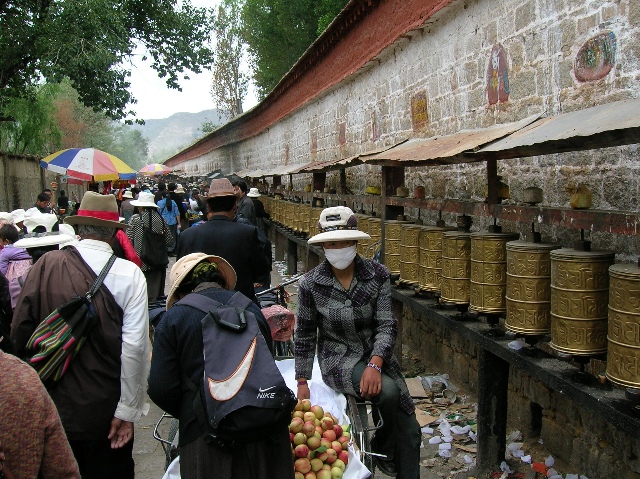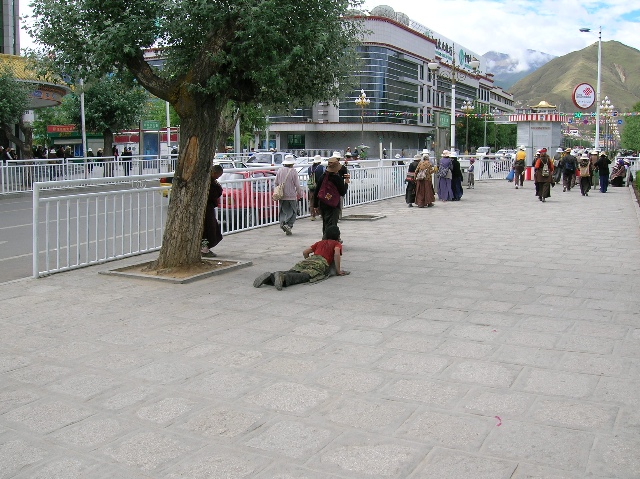| Prelude |
Day 6: Palace KoraI am back at the Potala at 9 a.m. sharp. I have abandoned any hope of finding Tai Chi players, or even sensual delights, but I can't get into the Potala either: even at this early hour all tickets for the day have been sold out.Outside, the crowds prostrating in front of the Potala are four or five deep:
I follow the crowd as they finish their prostrations and head off left. After a few hundred yards everyone ducks into a small alleyway with thousands of prayer wheels on the right-hand side. I have found the true Urban Kora: the circuit of the Potala.
Just like the Kora of the Jokhang temple, this one has its commercial side too, but the clientele and the prices are completely different. The customers are all Tibetan and know the value of a yuan. The alarm clock that cost 35 yuan ($4.50) at the Jokhang costs 5 yuan (60 cents) here. As well as the alarm clock I buy an excellent broad-brimmed hiking hat for $2 that would be at least $20 in the States, some delicious peas for 35 cents a pound, and last but not least some toilet paper for our long cross-county trip. Oddly, no-one is spinning any of the prayer wheels. The vendors have recording megaphones into which they shout their pitches and which then repeat them endlessly at the tops of their electronic voices. Toward the far side of the kora I see a young man throwing himself through the air, landing flat on his tummy, getting up, getting a running start, then throwing himself through the air again. I don't manage to get a picture of him throwing himself through the air: here he is just after landing. Note the pads on his hands, on which he will slide for ten or fifteen feet after first touching the ground.
In the afternoon I revisit the Jokhang and have a pleasant surprise. Up to now I have always gone fairly early in the morning, and seen devotees prostrating before the closed doors of the temple. I had assumed that the doors were always closed and that this was some kind of 'Wailing Wall', in the same way as the Jews' holiest temple is forbidden to them or that they set a place for the missing Messiah at holiday meals. But the truth is more prosaic: the temple opens at ten. Tourists pay seventy yuan and get in immediately: locals pay nothing but wait in a long, long queue that snakes all the way around the outside of the building. They are admitted only when someone else leaves, and the typical wait seems to be at least a couple of hours. The temple consists of literally hundreds of mini-temples, each with some kind of artistic representation of the divine. It's not really correct to use the term 'god' since the Tibetans don't believe that these representations ('Yidams') 'exist' in any solid sense, but see them more as useful idealizations. An analogy in our culture is that when we do geometry we assume that we idealized lines with no thickness, points of zero size, and an infinite flat and completely smooth surface to make our drawings on. We know none of these constructs actually exist, but we still use them to calculate with even when we calculate something real like the dimensions of a house. Similarly, in a Christian religious context, certain physical attributes of the divine (e.g. long white beard) as well as attributed emotions (anger, jealousy), family relationships (Father and Son) and physical props (Jesus enthroned on God the Father's right side) were perhaps never meant to be taken literally. I was under the impression that there was a statue of Chenrezig at the center of the temple that is the most sacred in Tibet, but the whole center of the temple seems to be off-limits and I see no such statue anyway. Blocking the gate to the center of the temple is a huge, loose pile of banknotes donated to the shrines, perhaps two feet high and five across, that is being sorted into denominations by lay volunteers. Most of the notes are for one mao (thirteen cents), the most common denomination used for making a donation in front of a shrine.Vast as it is, the pile probably only contains a few hundred dollars' worth of bills. The most touching aspect of this to me is that the locals queue up for hours simply to make a donation at the temple. The most touching sight of all was seeing an old woman with a large grease-gun in her hand, who queued all morning to earn the privilege of going round all the hundreds of prayer-wheels and greasing the axle of each one, an expression of calm and devotion on her face. Just before I leave, I a group of Chinese VIPs are actually admitted to the center of the temple. Their expressions are interesting. They want to fit in and show respect for their hosts, have absolutely no understanding of what is going on, yet are very receptive to the place's energy and importance. This is actually the ideal attitude for making a spiritual connection - what the Zen Master Shunryu Suzuki used to call 'Beginner's Mind'. I wonder how far their beginner's mind will take the Chinese into the spiritual dimension. |


